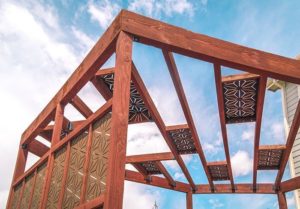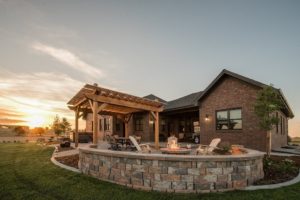These steps are designed to help you install your yard, but it is highly recommended that you consult with a landscape contractor before work begins. All Terrain is more than happy to help you along the way with your project from obtaining materials to consulting with the process.
[bra_list style=”colored-counter-list”]
- Measure the total square footage of area you wish to landscape with grass. You will need to order 4 cubic yards of compost per 1,000 sq. ft. of sod. Then, you will need to spread out the compost evenly throughout the proposed soded area and roto-till in the compost to amend the soil.
- Find out how much water is available from your home by turning on the irrigation tap and filling a 5-gallon bucket. Time how long it takes to fill up the bucket, then divide that time by 60 to find out how much water is available per minute. For example: If you filled the 5-gallon bucket in 15 seconds, there are 20 gallons of water available per minute. You’ll want to remember this number; you never want to use the total amount of water you have available on your sprinkler system because during times of high water usage in your home, your sprinklers will not work properly. So only use 2/3 of the total amount per zone. Once you have your water calculated, you can begin laying out your sprinkler system.
- Lay out your sprinkler system; this is the most important part of installing your system. You will need to decide if you are going to use spray heads or rotor heads. Rotor heads are typically utilized in larger areas, while spray heads are better suited for smaller areas. Next, measure the distance from end-to-end of your yard and find a number divisible that is shorter than the distance the type of head will throw. If you set your heads farther apart than they can throw, you will have poor coverage. Make sure to always have double coverage in every area of your yard to insure proper coverage.
- Assign each sprinkler head to a zone. Each type of head uses a different amount of water. Rotor heads have different nozzles that use different amounts of water. Typically, the 2-gallon nozzle is used. For spray heads, a quarter nozzle uses 1 gallon of water, a half nozzle uses 2 gallons, and a full nozzles uses 3 gallons. When assigning zones, make sure not to assign a spray head with a rotor head because these heads have different precipe rates, meaning each needs to run for a different amount of time. Make sure the zones aren’t using more than 2/3 of the water available from your home (calculated in Step 3).
- Once the sprinkler system is installed, you can add edging, that along with any plant material, weed barrier, rock, or mulch.
- Grade out your yard to make sure your yard will have proper drainage and that your sod will lay flat and look uniform throughout. It is best to use a large landscape rake while trying to grade your yard. Also, be sure to remove any rocks or debris from the dirt while raking.
- Now, you are ready to install sod. You should already have the measurement from Step 1, so you can order your sod. When installing sod, make sure to stagger your seams to insure a proper look and functionality of the new sod. It is always best to lay the sod going in the direction of your longest run to limit the amount of cuts to your sod.
- Once your new sod in installed, you will need to set your irrigation controller. New sod does not have very long roots, so it cannot hold very much water. In turn, you will need to water more frequently for less amounts of run time. During the hot months of June, July, and August, you will need to water four times a day for roughly 6 minutes on spray heads and 12 minutes on rotor heads. Spread out your start time throughout the hottest times of the day, roughly 8 a.m., 11 a.m., 2 p.m., and 5 p.m.
[/bra_list]


